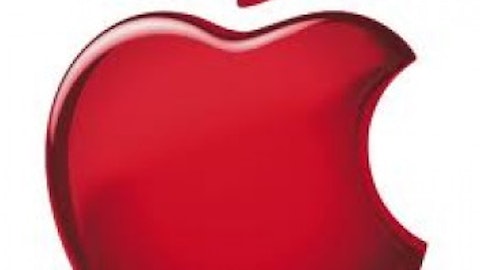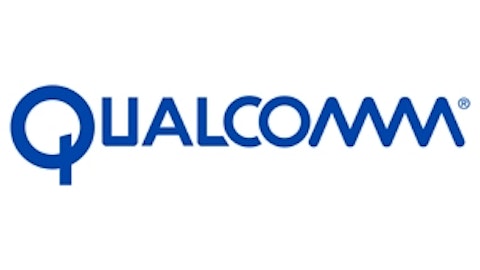If there is a chip company out there that could rightly be called the “Intel Corporation (NASDAQ:INTC) of Mobile,” it would be QUALCOMM, Inc. (NASDAQ:QCOM). For those unfamiliar with the story, Qualcomm is the leading merchant vendor of mobile applications processors and cellular platforms, and supplies chips to the likes of Apple Inc. (NASDAQ:AAPL) and SAMSUNG ELECT LTD(F) (OTCMKTS:SSNLF). Furthermore, Qualcomm owns a veritable war chest of patents on key wireless standards, which has allowed it to generate a very healthy royalty stream that has grown commensurate with the continued growth in mobile devices. However, at current levels, risk is much more heavily weighted to the downside.
Where do you go from up?
According to Strategy Analytics, QUALCOMM, Inc. (NASDAQ:QCOM) owned no less than a 43% share of the smartphone applications processor space in the first half of the year. Of the four remaining vendors in the top five, one (ST-Ericsson) will be exiting the business, and two (SAMSUNG ELECT LTD(F) (OTCMKTS:SSNLF) and Apple Inc. (NASDAQ:AAPL)) serve captive audiences (on their their own devices) and aren’t necessarily competing with Qualcomm. In short, Qualcomm completely owns the high-end smartphone apps processor market and competes briskly in the low-end market.

Everybody’s doing the LTE dance
While 2012 and 2013 were QUALCOMM, Inc. (NASDAQ:QCOM)-only on the LTE side of things, the 2014 landscape looks much more competitive. Broadcom Corporation (NASDAQ:BRCM) just picked up a choice set of LTE and LTE-Advanced assets in a fire sale. Intel Corporation (NASDAQ:INTC) is finally shipping a multimode voice and data LTE solution (the XMM 7160) and is on track to bring a next generation platform (XMM 7260) with carrier aggregation and Cat6 (300 Mbps) support during the first half of 2014. Additionally, NVIDIA Corporation (NASDAQ:NVDA) is in final stages of having its own integrated LTE solution validated on AT&T Inc. (NYSE:T)‘s network.
So, the problem for QUALCOMM, Inc. (NASDAQ:QCOM) is simple: With a new breed of competition, it will either see margin pressure or it will simply lose market share. In either case, this is a lose-lose for both sentiment and revenue/earnings growth (which has been fueled by the company’s booming semiconductor business).
What happens when Samsung gets its act together?
Another major concern is that QUALCOMM, Inc. (NASDAQ:QCOM) has significant exposure to SAMSUNG ELECT LTD(F) (OTCMKTS:SSNLF) on the semiconductor side of things. That is, many of Samsung’s marquee designs, such as the LTE versions of the Galaxy S4 and Galaxy Note, utilize Qualcomm modems and apps processors. If or when Samsung gets its apps processor and in-house modem efforts in order (Silicon Motion Technology Corp. (ADR) (NASDAQ:SIMO), Samsung’s RF chip supplier, has indicated that this is Samsung’s plan), Qualcomm loses a non-trivial amount of business.
That being said, SAMSUNG ELECT LTD(F) (OTCMKTS:SSNLF) (and every other smartphone vendor whose name isn’t Apple Inc. (NASDAQ:AAPL)) tends to go with the best chip for the job. If QUALCOMM, Inc. (NASDAQ:QCOM) can continue to outgun SAMSUNG ELECT LTD(F) (OTCMKTS:SSNLF)’s own internal chip teams (which are actually going to be stepping up their game with a custom ARM Holdings plc (ADR) (NASDAQ:ARMH)-compatible core that allows for more control over the performance/power characteristics of the chip over standard ARM cores), then it will probably keep those key spots, but if it can’t, then that could have a materially negative impact on the company’s financial performance.
It’s not all bad, though
Quite frankly, I’m not making a particularly bearish call on QUALCOMM, Inc. (NASDAQ:QCOM). It’s not particularly expensive and its cellular patent royalty base is secure, although a shift to 4G-only networks would have a negative impact on royalty rates (Qualcomm gets about 5% for each 3G device sold, whereas it only gets about 3.25% for each 4G device sold). However, what I do worry about is that there’s just not a lot of upside left and that the risk/reward of holding or buying shares at these levels is simply not attractive. Perhaps on a pullback, the risk/reward looks more favorable, but for now I have to stay on the sidelines.
The article Qualcomm’s a Great Company, but Not a Great Buy originally appeared on Fool.com.
Ashraf Eassa owns shares of Intel, NVIDIA, and Broadcom. The Motley Fool recommends Apple, Intel, and NVIDIA. The Motley Fool owns shares of Apple, Intel, and Qualcomm.
Copyright © 1995 – 2013 The Motley Fool, LLC. All rights reserved. The Motley Fool has a disclosure policy.




